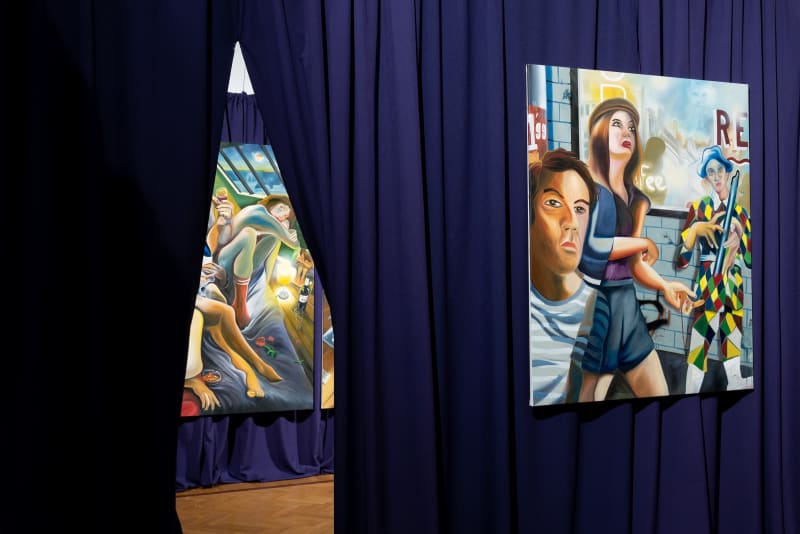Sometimes we see everything but understand nothing.
Yann Leto
Set in the heart of Rome, where myth and modernity overlap, Yann Leto’s exhibition Those That Watch, Those That Knowat Andrea Festa presents a new body of work exploring the blurred thresholds between awareness, ignorance, and performance.
Across five cinematic paintings and one central sculptural piece, Leto constructs a comic-strip-like sequence, one that unfolds across the gallery like a fragmented narrative. With symbolic and theatrical precision, he draws inspiration from masters such as Magritte and Botticelli, while channeling the postwar anxiety of Otto Dix. The result is a surreal and sharply ironic body of work that navigates the layers of self-deception, revelation, and voyeurism embedded in contemporary life.
The exhibition opens with Breaking News, a domestic tableau where a television flickers in the background and characters—both aloof and entranced—remain frozen in passive spectacle. A woman stares blankly forward while a background figure watches, detached yet knowing. The composition introduces the show's core dichotomy: those who observe and those who understand.
The central diptych, evocative of Dix’s Metropolis, replaces postwar class struggle with existential rupture. Here, we see scenes after an “explosion”—emotional or literal remains unspecified—where light and shadow converge to the point of disorientation. Characters are caught between awe and numbness, their banality disturbed by something greater than themselves.
In The End of the Day, a glass pane separates “the knowers” from the rest. It is a simple boundary, yet loaded with emotional and philosophical weight. How close we are to seeing clearly, yet how often we miss what’s right in front of us. The figures are caught in moments of reaction, trying to comprehend what they perhaps already know, or have long chosen to ignore.
The final painting presents a solitary woman in a Photo Booth. Adorned, illuminated, yet tormented, she stares into her own reflection. Behind her—a pigeon, the “common man’s bird”—lurks as a mundane reminder of unresolved truth. It is a portrait of self-conscious struggle, of beauty confronting the burden of knowing.
The central sculptural piece threads the visual narrative together—a tactile anchor in a world where surfaces are endlessly questioned. With a critical text by Thom Oosterhof, Those That Watch, Those That Know explores the roles we play and the truths we suppress. In Yann Leto’s hands, the gallery becomes a stage, and each canvas a curtain briefly lifted on the human condition.


